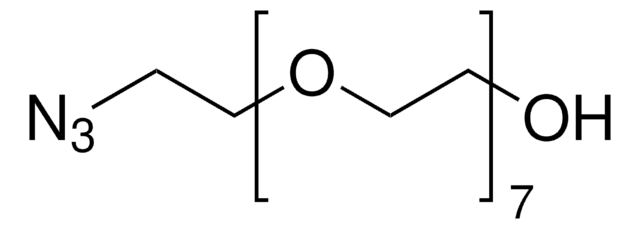Wszystkie zdjęcia(1)
Kluczowe dokumenty
900935
Poly(ethylene glycol) α-hydroxy-ω-azido terminated
average Mn 5,000
Synonim(y):
Glikol polietylenowy, α-hydroksy-ω-azido-PEG
Zaloguj sięWyświetlanie cen organizacyjnych i kontraktowych
About This Item
Wzór liniowy:
N3CH2CH2(OCH2CH2)nOH
Kod UNSPSC:
51171641
NACRES:
NA.23
Polecane produkty
Formularz
powder or chunks
Poziom jakości
masa cząsteczkowa
Mn 4000-6000 (by NMR)
average Mn 5,000
kolor
white to off-white
temp. przechowywania
−20°C
Szukasz podobnych produktów? Odwiedź Przewodnik dotyczący porównywania produktów
Opis ogólny
α-hydroksy-ω-azido-poliglikol etylenowy jest heterobifunkcyjną pochodną PEG, która może być stosowana do modyfikacji peptydów, białek lub innych zastosowań chemii biokoniugacji. Materiały PEGylowane znalazły szerokie zastosowanie w systemach dostarczania leków, wirusologii i immunologii, ponieważ włączenie PEG poprawia właściwości farmakologiczne, takie jak zwiększona rozpuszczalność w wodzie, zwiększona odporność na degradację (hydroliza białek), wydłużony okres półtrwania w obiegu i zmniejszona antygenowość. Oprócz PEGylacji, ten heterobifunkcyjny PEG może być również wykorzystywany do tworzenia sieci do zastosowań w inżynierii tkankowej lub dostarczaniu leków ze względu na jego podwójną reaktywność.
Zastosowanie
α-hydroksy-ω-azido zakończony poli(glikol etylenowy) posiada dwie różne, końcowe grupy funkcyjne: azydek i grupę hydroksylową. Terminalny azydek może ulegać cykloaddycji azydkowo-alkilowej katalizowanej miedzią(I) (CuAAC) lub cykloaddycji azydkowo-alkilowej promowanej szczepem (spAAC), w zależności od warunków reakcji i tożsamości alkinu. Ponadto, końcowy azydek może być zredukowany do aminy w łagodnych warunkach, do wykorzystania w innych reakcjach sprzęgania. Wolny hydroksyl pozwala na dodatkową funkcjonalizację lub wtórną reakcję sprzęgania.
Ta strona może zawierać tekst przetłumaczony maszynowo.
Kod klasy składowania
11 - Combustible Solids
Klasa zagrożenia wodnego (WGK)
WGK 3
Temperatura zapłonu (°F)
Not applicable
Temperatura zapłonu (°C)
Not applicable
Wybierz jedną z najnowszych wersji:
Certyfikaty analizy (CoA)
Lot/Batch Number
Nie widzisz odpowiedniej wersji?
Jeśli potrzebujesz konkretnej wersji, możesz wyszukać konkretny certyfikat według numeru partii lub serii.
Masz już ten produkt?
Dokumenty związane z niedawno zakupionymi produktami zostały zamieszczone w Bibliotece dokumentów.
Joseph G Plaks et al.
Bioconjugate chemistry, 26(6), 1104-1112 (2015-05-20)
Approaches that allow bioorthogonal and, in turn, site-specific chemical modification of proteins present considerable opportunities for modulating protein activity and stability. However, the development of such approaches that enable site-selective modification of proteins at multiple positions, including internal sites within
Sabrina M Hodgson et al.
Biomacromolecules, 17(3), 1093-1100 (2016-02-05)
A series of poly(ethylene glycol) (PEG) hydrogels was synthesized using strain-promoted alkyne-azide cycloaddition (SPAAC) between PEG chains terminated with either aza-dibenzocyclooctynes or azide functionalities. The gelation process was found to occur rapidly upon mixing the two components in aqueous solution
Kevin N Sill et al.
Biomacromolecules, 18(6), 1874-1884 (2017-05-06)
Described is the development of a polymeric micelle drug delivery platform that addresses the physical property limitations of many nanovectors. The system employs triblock copolymers comprised of a hydrophilic poly(ethylene glycol) (PEG) block, and two poly(amino acid) (PAA) blocks: a
Ian W Hamley
Biomacromolecules, 15(5), 1543-1559 (2014-04-12)
The remarkable diversity of the self-assembly behavior of PEG-peptides is reviewed, including self-assemblies formed by PEG-peptides with β-sheet and α-helical (coiled-coil) peptide sequences. The modes of self-assembly in solution and in the solid state are discussed. Additionally, applications in bionanotechnology
Nasz zespół naukowców ma doświadczenie we wszystkich obszarach badań, w tym w naukach przyrodniczych, materiałoznawstwie, syntezie chemicznej, chromatografii, analityce i wielu innych dziedzinach.
Skontaktuj się z zespołem ds. pomocy technicznej

![2-[2-(2-Azidoethoxy)ethoxy]ethanol solution ~0.5 M in tert-butyl methyl ether](/deepweb/assets/sigmaaldrich/product/structures/374/007/eea7ca74-41e4-4aac-af71-c93c37ec0a5a/640/eea7ca74-41e4-4aac-af71-c93c37ec0a5a.png)



